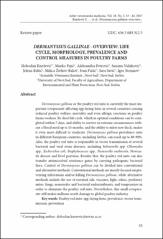| dc.description.abstract | Dermanyssus gallinae or the poultry red mite is currently the most important ectoparasite aff ecting egg-laying hens in several countries causing reduced poultry welfare, mortality and even allergic reactions in poultry farms workers. Its short life cycle, which in optimal conditions can be completed within 7 days, and ability to survive in extreme circumstances without a blood meal up to 13 months, and the ability to infest new flock, makes it even more diffi cult to eradicate. Dermanyssus gallinae prevalence rates in different European countries, including Serbia, can reach up to 80-90%. Also, the poultry red mite is responsible in vector transmission of several bacterial and viral avian diseases, including Salmonella spp, Chlamydia spp., Escherichia coli, Staphylococcus spp., Pasteurella multocida, Newcastle disease and Fowl poxvirus. Besides that, the poultry red mite can also transfer antimicrobial resistance genes by carrying pathogenic bacterial flora. Control of Dermanyssus gallinae can be divided into conventional and alternative methods. Conventional methods are mostly focused on preventing infestations and/or killing Dermanyssus gallinae, while alternative methods include the use of essential oils, vaccines, light, odors, predatory mites, fungi, nematodes and bacterial endosymbionts, and temperature in order to eliminate the poultry red mite. Nevertheless, this small ectoparasite still makes millions worth damage to global poultry industry. | en_US |
| dc.description.sponsorship | The research was supported by a Training school at Itea, Greece, provided by COST Action FA1404 “Improving current understanding and research for sustainable control of the poultry red mite Dermanyssus gallinae (COREMI)” and the Ministry of Education Science and Technological Development, Republic of Serbia, Project numbers TR 31084 and TR 31071. | en_US |

